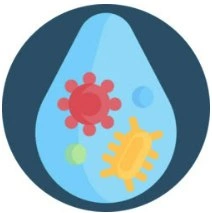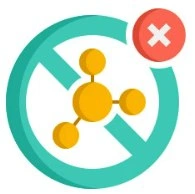We often say that reverse osmosis removes 99% of contaminants, listing a lengthy array of them. Today, let’s look at the other side of the question—what reverse osmosis cannot remove and why this happens.
What’s Inside Your Home Filter?
If you’re interested in this article, you likely already know what components make up your filter, but let’s briefly review this information.
Structurally, the system is a multi-stage water purification station in a compact form. Initially, the source water enters a block with three pre-filters (in some models, there are two). Inside the three housings are cartridges that trap mechanical particles, chlorine, and organic substances. This stage is primarily needed to protect the sensitive membrane element from these harmful substances.
After pre-treatment, water moves to the membrane, the main filtering element. Through reverse osmosis, it only allows water molecules and some ions to pass. This is where heavy metal ions are removed, as they are called “heavy” due to their high molecular weight, as well as hardness salts and most organic compounds.
After the membrane, water flows through an activated carbon filter, also called a post-filter, where any remaining gases and specific organic pollutants that may have slipped through the membrane and pre-filters are removed.
The mineralizer is an additional stage that does not purify water but instead adds magnesium and/or calcium, which are also removed during the purification process. For this reason, a slight buildup may occur in kettles after mineralized water is used.
Now let’s look in detail at what contaminants the filter removes and how it works.
Does Reverse Osmosis Remove Bacteria and Viruses?

Bacteria and viruses are a major factor in water quality and the main concern for water utilities. Water treatment stations dose chlorinated compounds to destroy microorganisms. However, cases of infectious diseases spread through water still occur today in both centralized and decentralized sources.
Reverse osmosis can remove 100% of bacteria, viruses, and parasite eggs, as these particles are too large to pass through the membrane. Therefore, reverse osmosis water is safe for drinking without boiling.
Does Reverse Osmosis Remove Heavy Metals and Nitrates?
The toxicity of metallic chemical compounds increases with their atomic number and molecular mass. Fortunately, the removal efficiency also increases with their mass, meaning the more toxic the element, the less likely it is to pass through the membrane.
Research on Dow Filmtech TW30-1812-50 membranes confirms that they effectively remove copper, zinc, and nickel salts, and are also effective in removing arsenic, lead, and other metals. As for nitrates, reverse osmosis is also effective in removing them.

However, reverse osmosis does remove sodium, potassium, magnesium, and calcium, which are beneficial for humans. Water is not the main source of these minerals, and they can be obtained from food. Additionally, special mineralizers are available to add essential minerals back into the water, including calcium and magnesium, beneficial for our bodies.
In industry, reverse osmosis is one of the most common methods for wastewater treatment from heavy metals, and in household settings, there is currently no alternative to this technology.
Does Reverse Osmosis Remove Chlorine?

To put it simply, reverse osmosis membranes don’t “like” chlorine, and chlorine doesn’t “like” them. Chlorine can damage the thin polyamide membrane layer, significantly reducing its lifespan, but it can also “slip through” the membrane. However, it’s not that simple. As mentioned earlier, the reverse osmosis system is designed with one or two activated carbon cartridges in front of the membrane to remove chlorine and organic substances (which we’ll discuss below). Organic compounds, even after preliminary treatment, accumulate over time on the membrane surface and are actively oxidized, preventing them from passing through the membrane.
Does Reverse Osmosis Remove Organic Compounds?
Surface water sources contain natural organic substances. Chlorine oxidizes them, resulting in toxic chlorinated organic compounds. In addition to natural organics, various chemical pollutants may also be present in the water, including phenolic compounds, pesticides washed from fields, industrial wastewater, and more. Chlorinated organics are dangerous because they are proven carcinogens when consumed long-term, even in small concentrations.
Activated carbon combined with a reverse osmosis membrane can effectively remove this group of contaminants. Numerous studies have demonstrated positive results in removing organic compounds, pesticides, and other pollutants.
Resources:
- Bakalár, Tomáš & Milan, Búgel & Lucia, Gajdošová. (2009). Heavy Metal Removal Using Reverse Osmosis. Acta Montanistica Slovaca. 14.
- Geucke, T., Deowan, S. A., Hoinkis, J., & Pätzold, C. (2009). Performance of a small-scale ro desalinator for arsenic removal. Desalination, 239(1-3), 198–206.
- Schoeman, J. J., & Steyn, A. (2003). Nitrate removal with reverse osmosis in a rural area in South Africa. Desalination, 155(1), 15–26.
- Plakas, K. V., & Karabelas, A. J. (2012). Removal of pesticides from water by NF and RO membranes — a review. Desalination, 287, 255–265.








